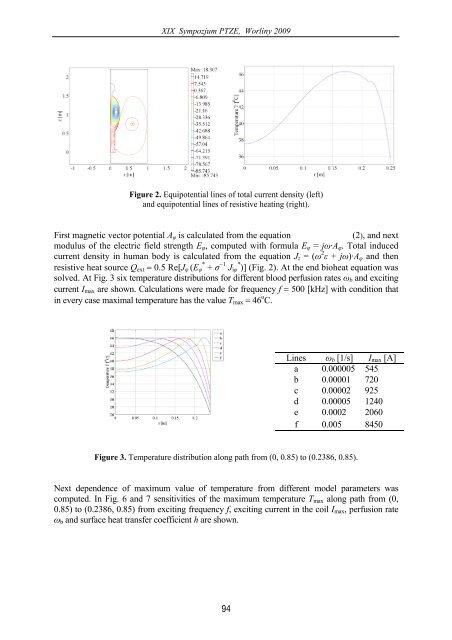XIX Sympozjum Srodowiskowe PTZE - materialy.pdf
XIX Sympozjum Srodowiskowe PTZE - materialy.pdf
XIX Sympozjum Srodowiskowe PTZE - materialy.pdf
You also want an ePaper? Increase the reach of your titles
YUMPU automatically turns print PDFs into web optimized ePapers that Google loves.
<strong>XIX</strong> <strong>Sympozjum</strong> <strong>PTZE</strong>, Worliny 2009<br />
Figure 2. Equipotential lines of total current density (left)<br />
and equipotential lines of resistive heating (right).<br />
First magnetic vector potential Aφ is calculated from the equation (2), and next<br />
modulus of the electric field strength Eφ, computed with formula Eφ = jω·Aφ. Total induced<br />
current density in human body is calculated from the equation Jz = (ω 2 ε + jω)·Aφ and then<br />
resistive heat source Qext = 0.5 Re[Jφ (Eφ * + σ −1 Jiφ * )] (Fig. 2). At the end bioheat equation was<br />
solved. At Fig. 3 six temperature distributions for different blood perfusion rates ωb and exciting<br />
current Imax are shown. Calculations were made for frequency f = 500 [kHz] with condition that<br />
in every case maximal temperature has the value Tmax = 46 o C.<br />
94<br />
Lines ωb [1/s] Imax [A]<br />
a 0.000005 545<br />
b 0.00001 720<br />
c 0.00002 925<br />
d 0.00005 1240<br />
e 0.0002 2060<br />
f 0.005 8450<br />
Figure 3. Temperature distribution along path from (0, 0.85) to (0.2386, 0.85).<br />
Next dependence of maximum value of temperature from different model parameters was<br />
computed. In Fig. 6 and 7 sensitivities of the maximum temperature Tmax along path from (0,<br />
0.85) to (0.2386, 0.85) from exciting frequency f, exciting current in the coil Imax, perfusion rate<br />
ωb and surface heat transfer coefficient h are shown.




